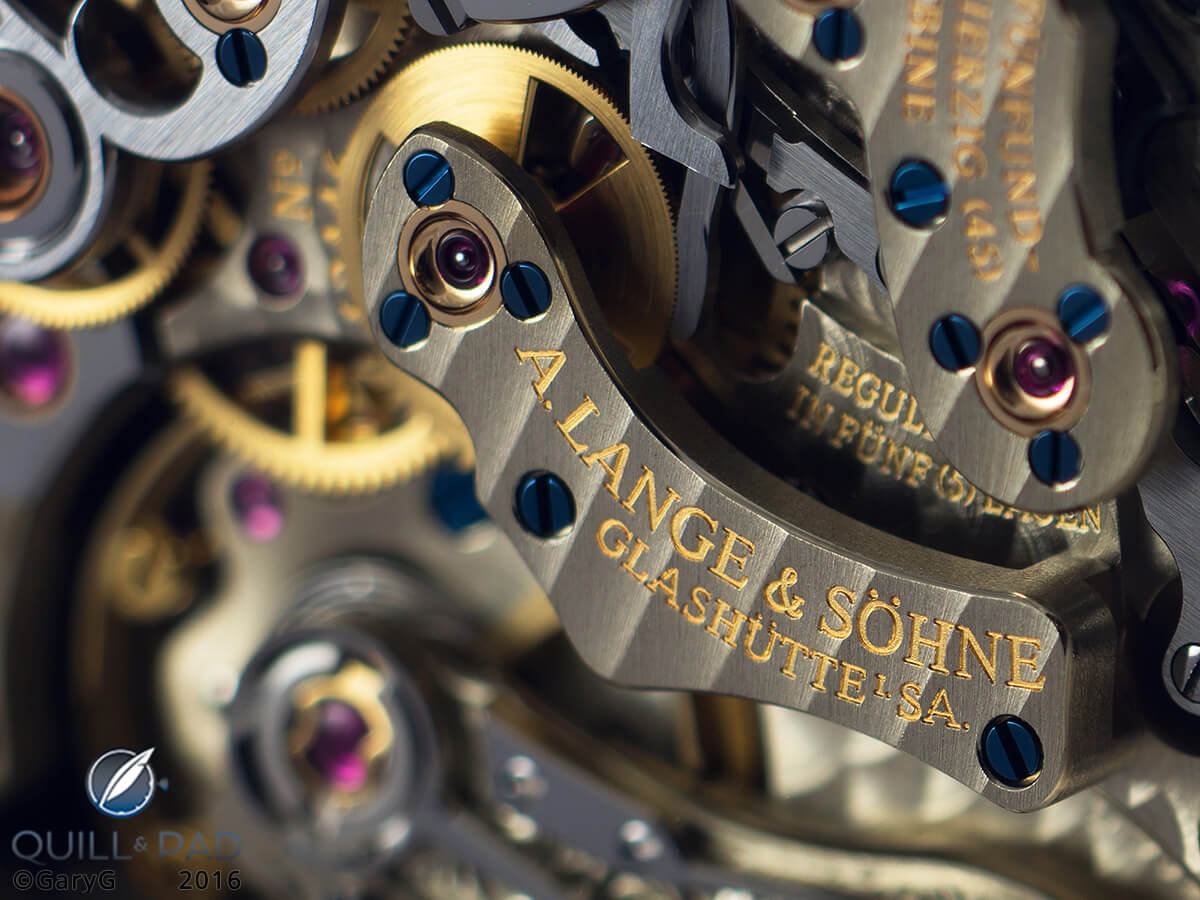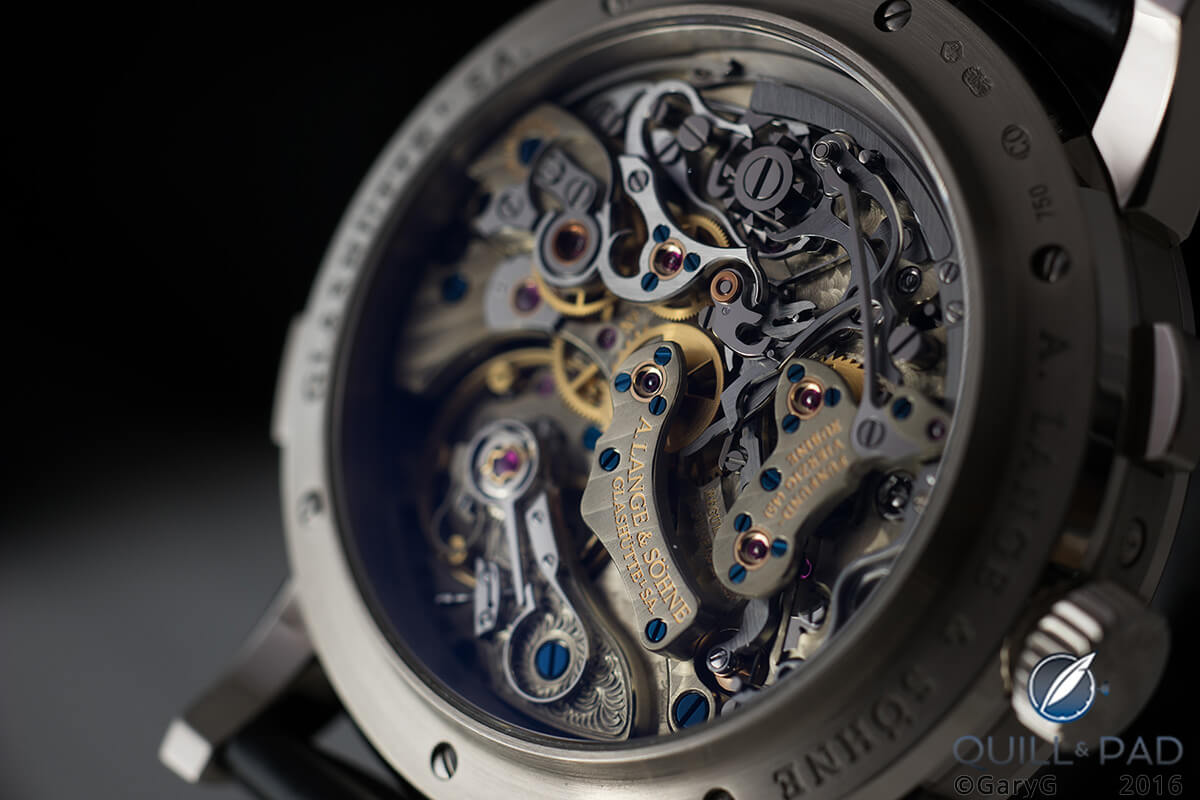by GaryG
The date: January 13, 2012.
The place: Glashütte, Germany, where one of my best friends had arranged for the two of us to visit A. Lange & Söhne prior to migrating to Geneva for SIHH week.
The vision: my friend extended his arm from the sleeve of his shirt, and what I saw left me reeling – my first view of the A. Lange & Söhne Datograph Perpetual in white gold.
Why I bought it
I was confident from that very moment that this was a watch for me; but pursuit of the piece took four long years. As the months passed, I began to think of it as the most extended impulse purchase of all time.
The craving started on that trip as I swapped my Double Split for my friend’s piece for the day and continued as I hectored him at every opportunity to sell his watch to me.
Finally, just a few months ago the stars aligned, and I was able to take the “Dato Perp” home.
Why did it take so long? Among other things, this particular watch is a rarity. While today many feel that the white gold/grey dial variant is the definitive Datograph Perpetual, like many cult watches it was not highly in demand in its initial incarnation (in 2014, Lange re-introduced this watch with baton-shaped hour markers rather than Roman numerals and with a changed color scheme for the hands).
By various estimates, between 50 and 70 examples of the first-generation Datograph Perpetual in white gold exist; and if my search experience is any indication, their owners are inclined to hold them tight.
In my friend Terry’s collecting taxonomy, the Datograph Perpetual definitely falls in the “investment” realm – a watch with fairly predictable market value that is important in its own right and can be a foundational element within a collection.
Even if it weren’t such a piece, I’d have been obsessed with it anyway!
Why I love it
In my humble opinion, this is just one great-looking watch. For me, the platinum version is nice and the pink gold even better, but the white/grey combination is the version of the Datograph Perpetual to have.
I’ve heard folks complain that the dial is a bit too busy, but for me there’s just enough going on to make it interesting. I think that a slightly cluttered look is actually part of what makes a watch look like a Lange; and when it comes to a perpetual calendar, the key indication is the date, which is front and center here.
There are some mechanical devices that are almost universal in their appeal, and this is one of them. The Datograph movement as seen from the reverse side of the watch draws us in with its dimensionality as well as its array of hues and surface treatments.
Of course, A. Lange & Söhne is known for its use of untreated German silver, and in my personal watch this metal has acquired just enough of a patina to bring real warmth to the view. I’m also really pleased with the overall quality of finishing of this particular piece: it’s assertive (note the pronounced depth of the striping in the photo above) but uniformly attractive throughout the movement.
And there are a few lovely hand-filed internal angles to show off the craftsperson’s touch.
With A. Lange & Söhne, one can always be assured of thoughtful functional design, too. That pusher at the upper edge of the photo, near 10 o’clock on the case? It simultaneously adjusts all of the calendar indications with a single push, but only when the crown is pulled out for safety.
The chronograph is also highly advanced: it both snaps the minute indicator forward instantaneously each time the chronograph second hand reaches 60 and flies back all indications to zero without having to be stopped in true Datograph style.
And it keeps time, too! Quite well, in fact, at least as far as the timing app on my phone can tell.
As an amateur macro photographer, I love nothing more than a watch that sets up well in varying lighting conditions and positions. The visual interest of the Datograph Perpetual, the not-quite-monochromatic look of the dial side with its splashes of color, and the great anti-reflective coatings used by A. Lange & Söhne make this watch a treat to shoot.
I’ve spent hours with the Datograph Perpetual in the light tent over the past few months, and it never fails to reward the effort with shots like the ones below, taken using a variety of techniques.

Film Noir look: high-contrast view of the A. Lange & Söhne Datograph Perpetual with strong side lighting
This watch doesn’t just perform well in the light tent, though. It looks great on the wrist in a variety of light conditions and wears well due to its pleasant weight and great proportion of height to diameter.
My final reason for loving this watch may seem a bit odd, but is nonetheless true: it both complements my “mighty” A. Lange & Söhne Double Split and stands up to it in every way.
When my “other” major A. Lange & Söhne piece was a pink gold Datograph, it somehow seemed to pale in the presence of what is arguably the world’s greatest chronograph. For me, the Datograph Perpetual is fully capable of holding its own with the addition of the perpetual calendar capability, and I find myself reaching for it and my Double Split in my watch box with about the same frequency.
Any quibbles?
Either good or bad news, depending on one’s point of view: the perfect watch hasn’t been made yet, at least in my view!
There’s so much to love about this watch that I feel a bit bad wanting even more. This year’s new Datograph Perpetual Tourbillon (see A. Lange & Söhne Presents Two Perpetual Calendar Tourbillons: Datograph Perpetual Calendar Tourbillon And New Lange 1 Tourbillon Perpetual Calendar) has an instantaneous perpetual calendar, and even though I don’t find myself sitting up nights watching the big date on my watch slowly creep forward from one to the next, I do admire the instantaneous change complication and would love to have it on my watch.
Some other folks complain about the power reserve, but for me any opportunity to indulge in the legendary winding feel and sound of this movement is a pleasure. And I find that the moon phase window, which admittedly looks a bit small in most photos, actually seems in good proportion when the watch is seen in the real world.
Is it for you?
I bought it, but is this a watch that might be suitable for your collection? You might want to consider it if:
- Like me, you are struck by the distinctive looks, both front and rear
- You’ve always wanted a perpetual calendar chronograph but for some reason haven’t gone the Patek Philippe route or you find the Germanic style more to your taste
- The technical sophistication of both the instantaneous flyback chronograph and the single-pusher perpetual calendar turns you on
- You are keen to buy a factory-fresh complicated A. Lange & Söhne and the current-production white gold watch with its clean baton-index look speaks to you
Happily, not every watch is for everyone! From my experience, you might want to direct your acquisitive energies elsewhere if:
- The combination of perpetual calendar, chronograph, and big date indications makes the look just a little too fussy for you
- You can’t imagine owning a perpetual calendar that has to be wound by hand rather than kept on a mechanical winder
- You just have to have a platinum, black-faced Datograph before you branch out to other A. Lange & Söhne chronographs
Quick Facts A. Lange & Söhne Datograph Perpetual
Case/dial combinations: pink gold with “argenté” (silvered) dial and white gold with grey dial; size 41 x 13.5 mm; previously produced in platinum
Movement: manually wound Caliber L952.1 with 36 hours of power reserve, 2.5 Hz/18,000 vph frequency, assembled twice
Functions: hours, minutes; hacking seconds; chronograph with flyback and precisely jumping minute counter; perpetual calendar with large date, day of week, month, leap year; moon phase display; day/night indication
Price: €115,800
Production years: 2006 onward
* This article was first published on March 14, 2016 at Why I Bought It: A. Lange & Söhne Datograph Perpetual.
You may also enjoy:
Why I Bought It: A. Lange & Söhne 1815 Rattrapante Honeygold Homage to F.A. Lange
Why I Bought It: A. Lange & Söhne Double Split
Why I Bought It: A. Lange & Söhne Odysseus (A Photofest!)
A. Lange & Söhne Lange 1 Perpetual Calendar: Nothing More, Nothing Less
Leave a Reply
Want to join the discussion?Feel free to contribute!




































































I can’t help but wonder, maybe you know, who was the main designer of this watch ? I also wonder how many designers threw in their 2 cents worth at it ?
I don’t know personally but when I am with Lange folks again will do my best to ask. As Reinhard Meis was the design chief behind the Datograph and this follows the same design principles I would assume that he had a significant role in its conception, but as you say others may also have suggested or dictated modifications.
An intriguing question! Perhaps Elizabeth can chime in, or as I say above I can take it up with Lange friends at some point.
Best, Gary
What an insightful post! The A. Lange & Söhne Datograph Perpetual is truly a masterpiece. I appreciate the detailed reasons behind your purchase decision—it’s clear that this piece is not only a stunning watch but also a valuable addition to your collection. The craftsmanship and attention to detail that Lange puts into their pieces are simply unmatched. I look forward to hearing how you enjoy it over time!